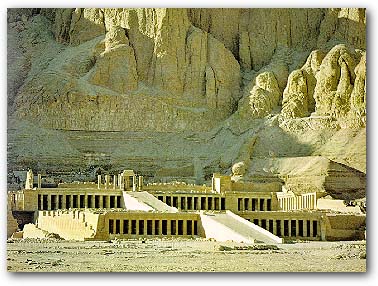| The Temple of Deir el Bahari (XVIII
Dyn) 
The mortuary temple of Queen Hatshepsut is one of the most dramatically situated in the
world. The queen's architect, Senenmut, designed it and set it at the head of a
valley overshadowed by the Peak of the Thebes, the "Lover of Silence," where lived the
goddess who presided over the necropolis. A tree lined avenue of sphinxes led up to the
temple, and ramps led from terrace to terrace. The porticoes on the lowest terrace are out of
proportion and coloring with the rest of the building. They were restored in 1906 to protect
the celebrated reliefs depicting the transport of obelisks by barge to Karnak and the
miraculous birth of Queen Hatshepsut. Reliefs on the south side of the middle terrace show the
queen's expedition by way of the Red Sea to Punt, the land of incense. Along the front of the
upper terrace, a line of large, gently smiling Osirid statues of the queen looked out over the
valley. In the shade of the colonnade behind, brightly painted reliefs decorated the walls.
Throughout the temple, statues and sphinxes of the queen proliferated. Many of them have
been reconstructed, with patience and ingenuity, from the thousands of smashed fragments
found by the excavators; some are now in the Cairo Museum, and others the Metropolitan
Museum of Art, New York.
|





